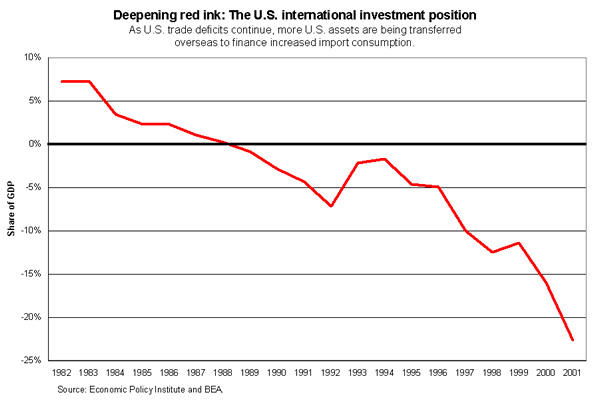A weekly presentation of downloadable charts and short analyses designed to graphically illustrate important economic issues. Updated every Wednesday.
Snapshot for July 3, 2002.
Hard landing in store as debt deepens
America’s trade deficits are financed either by borrowing from foreigners or by reducing the stock of U.S. assets abroad. Either case increases the United States’ net international indebtedness. The borrowing required to cover chronic trade deficits since the 1980s has transformed the United States from the world’s largest creditor nation into the world’s largest debtor (with negative net assets). The U.S. net international investment position declined sharply from 1982 through 2001, as a share of GDP. The United States was a net creditor nation as recently as 1988 but has since seen its accumulated net international debt (including foreign direct investment valued at current market prices) soar to 22.6% of GDP, or about $2.3 trillion in 2001, making the United States the world’s largest debtor nation (see figure below). In addition, most projections of US and international economic activity see US trade deficits and net international indebtedness continuing to grow rapidly over the next five to 10 years.

The financial disasters of the 1980s and 1990s in both developing and industrialized countries have clearly shown that too much external borrowing and accumulated international liabilities can precipitate financial crises and economic collapses. Whenever a country’s trade deficit becomes large and persistent, questions arise as to how large the country’s net debt can become.
The deeper the United States gets into debt, the larger and more draconian the remedial policies will ultimately have to be. There are only two ways in which the trade deficit and US debts can be quickly reduced: by sharply devaluing the dollar (to make US exports cheaper and imports more expensive), and by rapidly contracting the economy (thereby reducing demand for imports). The risk of a “hard landing” that quickly reduces US current account deficits at huge costs to the economy must be acknowledged and addressed by policy makers in order to safeguard the continued prosperity of the American economy and to avoid a global financial crisis.
This week’s Snapshot by EPI economist Robert E. Scott, with research assistance by Adam Hersh.
Check out the archive for past Economic Snapshots.
